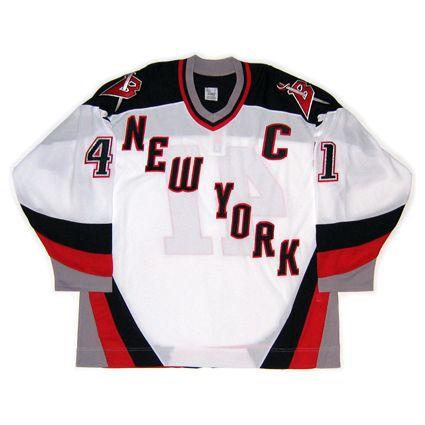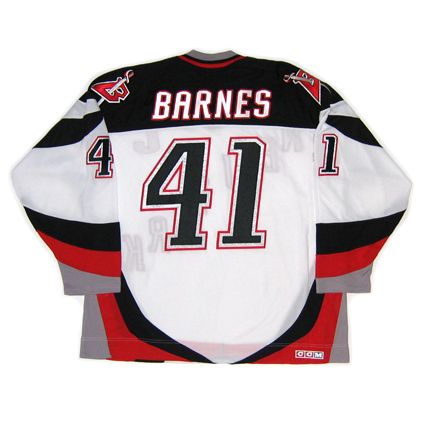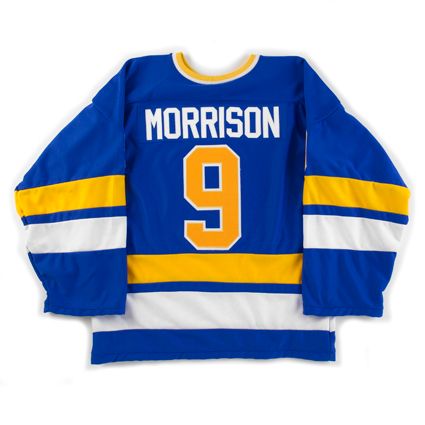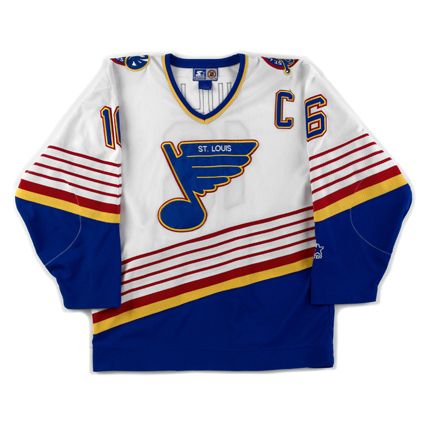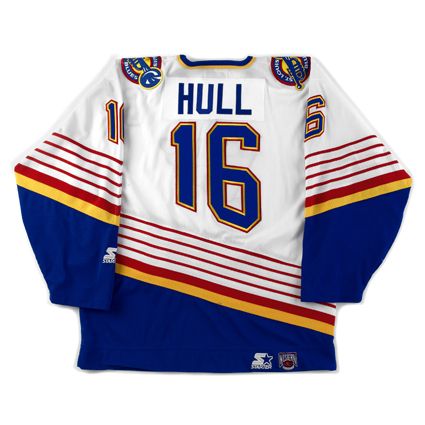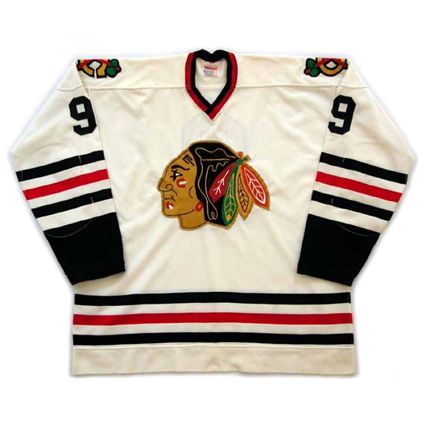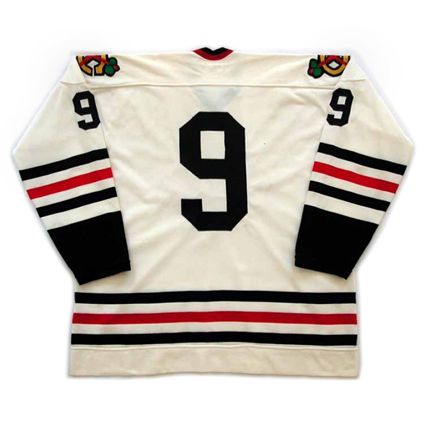Saturday, December 26, 2009
1978 Team Canada Wayne Gretzky World Juniors Jersey
The 2010 IIHF World Under 20 Championship kicks off today in Regina and Saskatoon, Saskatchewan in Canada with four games, as the Czech Republic takes on Sweden at 1 PM Central Standard Time in Regina. Games later today include hosts Canada vs. Latvia at 3 PM, Russia vs. Austria at 5 PM and Slovakia against the USA at 7 PM, a game which can be viewed in the US on the NHL Network, whose complete schedule can be seen here. Fans in Canada can view the TSN schedule of games here.
The NHL Network will air 16 games, including all the USA games in the preliminary round, plus six additional games. They will then feature all six medal round games, with the quarterfinals on January 2nd, the semifinals on 3rd and both the Bronze and Gold Medal Games on January 5th.
The countries competing this year are; Group A - Canada, Slovakia, USA, Latvia and Switzerland. Group B, the "Group of Death", comprises Sweden, Russia, Czech Republic, Finland and Austria, with only the top three from each group advancing to the Medal Round elimination playoffs.
Meanwhile, the bottom two teams in each group are sent to the four team Relegation Round. When completed, the two bottom teams will be relegated down to the Division 1 level and replaced in the 2011 tournament by Germany and Norway, who earned promotion to the Top Level with victories in the Division 1 Groups A and B earlier this year.
Anyone who is anyone in the NHL has participated in the World Juniors, including the likes of Viacheslav Fetisov, Wayne Gretzky, Jari Kurri, Igor Larionov, Mario Lemieux, Steve Yzerman, Esa Tikkanen, Brian Leetch, Alexander Mogilny, Sergei Fedorov, Jeremy Roenick, Mike Modano, Pavel Bure, Jaromir Jagr, Eric Lindros, Ziggy Palffy, Scott Neidermayer, Alexi Kovalev, Peter Forsberg, Markus Naslund, Paul Kariya, Jarome Iginla, Miikka Kiprusoff, Marian Hossa, Daniel Sedin, Henrik Sedin, Simon Gagne, Henrik Lundqvist, Zach Parise, Marc-Andre Fleury, Ryan Getzlaf, Jeff Carter, Alexander Ovechkin, Dion Phaneuf, Sidney Crosby, Evgeni Malkin, Phil Kessel, Nicklas Backstrom, Patrick Kane, Jonathan Toews, Carey Price and most recently, John Tavares. You may not know the top players in this year's tournament now, but rest assured, you will soon enough.
The "World Juniors" were first held in 1977 after three years of unofficial events, all won by the Soviet Union, and are particularly popular in Canada, where they are treated as practically a 11 day national holiday.
The original tournament was hosted by Czechoslovakia, which saw the Soviet Union capture the first of four consecutive championships. Sweden broke the Soviet stonghold on the title by winning in 1981 in West Germany, while Canada captured their first gold the following year in the United States before the Soviets put together a pair of back to back championships in 1983, becoming the first host to win, and 1984.
After wins by Canada and the Soviet Union, Finland broke through to take their first title in 1987 when the infamous "Punch-up in Piestany" occurred, as a 20-minute bench clearing brawl between the Canadians and Soviets broke out, which led to the arena lights being turned off in an attempt to restore order and both Canada and the Soviet Union expelled from the tournament as a result.
The event spawned our all-time favorite hockey quote ever:
"You don't like to see 20 kids punching 20 other kids.
It's not a disgrace. It's hockey." - Michael Farber.
Canadian fans might also enjoy reading Red, White, and Gold: Canada at the World Junior Championships 1974-1999 by noted hockey author Andrew Podnieks.
Canada returned to the top in 1988 in Moscow, followed by the Soviets in 1989. Canada went on a tear and captured seven of the next eight tournaments from 1990 to 1997, with only the Soviet Championship in Germany in 1992 breaking the Canadian domination. Oddly, the Canadians did not even medal that year.
Then, a most unusual thing happened. Finland took it's second and most recent title in 1998, followed by the first for Russia in 1999 before the Czech Republic captured not one, but it's first two titles in a row in 2000 and 2001.
Russia won back to back in 2002 and 2003 followed by the United States winning it's first World Juniors in 2004 in Finland, making for seven straight years without gold for Canada.
The Canadians rebounded, starting with the Dream Team in 2005, a roster loaded with future NHL talent, aided in part by the availability of some players due to the 2004-05 NHL Lockout. Their domination of the tournament in Grand Forks, North Dakota kicked off a run of titles that now stands a five consecutive, a streak they will be looking to extend on home ice in this year's tournament.
The championship titles currently stand at 15 gold medals for Canada, 12 for the Soviet Union/Russia, two each for Finland and the Czech Republic and one for Sweden and the United States. The Soviet Union/Russia leads all medals with 28 to Canada's 25 with silver and bronze included in the totals. The only other countries to medal outside the six who have already won gold are Switzerland and Slovakia with one bronze each in 1998 and 1999 respectively.
The host country has won in 1983 (Soviet Union), 1991, 1995, 2006 and 2009 (Canada) and 1998 (Finland) - just six out of 33 tournaments.
With sparse attendance frequent at nearly all venues not in or near Canada, the Canadians have become more and more frequent hosts, as they hosted 1 out of the first 9 tournaments, but will now host three out of four between 2009 and 2012, with the other taking place on the Canadian border in Buffalo, New York in 2011, no doubt repeating the sea of waving maple leaf flags seen in Grand Forks, North Dakota in 2005 when we at Third String Goalie were in attendance.
In honor of this year's host, today's featured jersey is a 1978 Team Canada Wayne Gretzky World Juniors jersey worn by Gretzky as a 16-year-old when he led Team Canada in scoring and was named Best Forward in the tournament while Canada took home the bronze medal.
For some reason unknown to us, Canada opted for a white home jersey with a blue Maple Leaf design and blue numbers on the back, adorned with a red maple leaf on each arm, and even more oddly, a blue road jersey with a white logo and numbers, also adorned with the same red maple leaves on each arm. The red maple leaf on the blue background is especially low contrast and would have clearly benefitted from being outlined in white, or more obviously been improved by being a white leaf on a proper red jersey!
First up in today's video section is a 16 year old Wayne Gretzky being interviewed at the 1978 World Juniors while wearing today's featured jersey.
Let's take a look back at the Top 10 Moments from the Canadians recent five year winning streak.
Now that you've seen the Top 1o moments from the last five years, let's focus on last year's tournament, which included an escape by the Canadians with mere seconds remaining against Russia in the semi-finals.
Here is the infamous 1987 brawl in Piestany which got both the Canadians and Soviets expelled from the tournament, costing the Canadians a medal.
Labels:
Gretzky,
World Junior Championships
Friday, December 25, 2009
2001-02 Buffalo Sabres "New York" Stu Barnes Jersey
Merry Christmas!
We have two posts today, so after today's usual "jersey o' the day" post about the life and times of Stu Barnes, be sure to scroll down to our special hockey holiday video selections, which have a little something for everyone!
********************
Born on Christmas Day in 1970, Stu Barnes was drafted 4th overall in the 1989 NHL Entry Draft by the Winnipeg Jets while in the process of scoring 389 points in 204 games during his three seasons in the Canadian junior Western Hockey League.
He would make his NHL debut with Winnipeg in the 1991-92 season and score his first NHL goal, along with 7 more, plus 9 assists for 17 points in 46 games that season.
His time in Winnipeg was short-lived however, as he was traded to the Florida Panthers. He would spend parts of four seasons in Florida, highlighted by their run to the Stanley Cup Finals in 1996. Barnes would contribute to the playoff run with 16 points in 22 games during "The Year of the Rat".
During the 1996-97 season, Barnes was dealt to the Pittsburgh Penguins. His offensive numbers would take a leap upwards in his new environment, and he would set career highs in 1997-98 with 30 goals and 35 assists for 65 points. He would never exceed 20 goals in any other of his 16 seasons in the NHL.
The following season Barnes was once again moved, this time to the Buffalo Sabres in exchange for Matthew Barnaby. While he only played in 17 regular season games that season for the Sabres, he was with them all the way throughout the playoffs, totaling 21 games, which included 7 goals and 3 assists as the Sabres made it all the way to the Stanley Cup Finals.
He was named team captain for the Sabres at the start of the 2001-02 season, during which today's featured jersey was worn following the terrorist attacks on September 11th.
Barnes popularity with the Sabres fans during his five seasons in Buffalo was aided by the calls of announcer Rick Jeanneret's calls of "Stuuuuuuuuuuuu Barnes!" following his goals. However, the last place Sabres began a rebuilding process in 2002-03, which including trading team captain Barnes to the Dallas Stars.
A steady and reliable performer in Dallas, Barnes would play an average of 79 games in the final four seasons of his career, scoring 11, 15, 13 and 12 goals in each season.
He would retire following the 2007-08 season with 1136 games played with 261 goals and 336 assists for 597 career points.
Today's featured jersey is a 2001-02 Buffalo Sabres "New York" Stu Barnes jersey. This jersey features Barnes' captain's "C" as well as the special "New York" cresting, which replaced the normal Sabres logo for this one game only.
The highest bids were $20,010 for Mark Messier's Rangers jersey, $15,010 each for Mike Richter and Brian Leetch of the Rangers, $9030 for Theo Fleury's Rangers jersey and $8030 for Eric Lindros of the Rangers with the highest Sabres jersey being Barnes at $5885. In total, 44 jerseys were auctioned off and over $215,000 was raised.
This is one of the more unique jerseys in the Third String Goalie collection. A blank Sabres CCM was first purchased. After locating the proper Sabres shoulder patches on ebay, the jersey was then sent in for customizing, with not only Barnes name and number, but the "New York" cresting recreated in the same font at the Sabres names on the back.
Here is a brawl from the October 7th, 2001 game when the Sabres and Rangers wore their special "New York" jerseys. You can see the Sabres jersey at the start before the players tie up. The 9/11 memorial ribbon patch can clearly be seen on the Rangers player's shoulder during the fight and you do get a clear look at both fighters jerseys at the end of the video when the fight is broken up and they are leaving the ice.
Plus, any day we get to post a video featuring Sabres announcer Rick Jeanneret is a good day.
Just because we can, some more Rick Jeanneret excitedly calling a few goals by Stuuuuuuuuuuuu Barnes!
Labels:
9/11,
Barnes,
Buffalo Sabres
Merry Hockey Christmas! Joyeux Hockey Noël!
Merry Hockey Christmas! Joyeux Hockey Noël!
We hope Santa was good to you this year and brought you the jersey you've been wanting.
We also hope you enjoy our special video collection today.
Don't forget - as our countdown clock in the right hand column shows - tomorrow the World Junior tournament begins, the annual festival hockey featuring "Tomorrow's Stars Today"!
And now...
On to the videos!
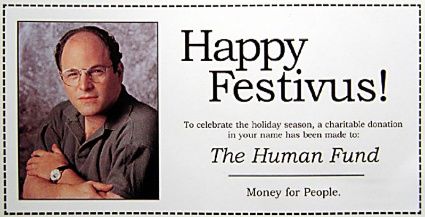
Again, Merry Christmas and Happy Holidays, and for those of you who do not celebrate Christmas, Happy Festivus!

Labels:
humor
Thursday, December 24, 2009
1973-74 Minnesota Fighting Saints George Morrison Jersey
Born on this date in 1948, George Morrison became a star for the University of Denver Pioneers of the WCHA and later played in the NHL and the WHA.



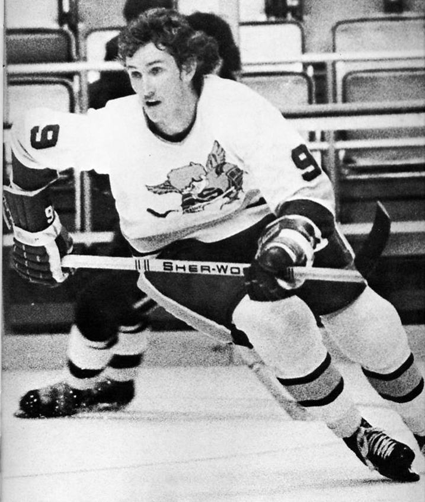
Sadly, that remarkable record died with the WHA and is a forgotten achievement today, although Morrison's stick from that game does reside in the archives of the Hockey Hall of Fame in Toronto.

In his freshman season at DU, Morrison scored 58 points on 40 goals and 18 assists in just 32 games, leading the WCHA in scoring. Denver would reach the NCAA National Championship game against Cornell and their goaltender and future NHL star and Hall of Famer Ken Dryden. Morrison would score the Pioneers second goal of the game enroute to a 4-3 victory and the title.

"It's funny how I wound up at Denver," Morrison said. "I'd played around my home town [Scarborough, Ontario], but I had no particular plans. Then a friend who had gone to Denver asked me if I'd like to play hockey in college. I said sure. Within a few days I was out here taking exams. It all happened only a few weeks before school started, and I couldn't be happier."
The next season was more of the same for Morrison, as he led the WCHA in scoring with 30 goals in 32 games and a 57 point season and being named a WCHA First Team All-Star and NCAA All-American for the second consecutive season.

He would sign as a free agent with the St. Louis Blues in September of 1970 and score 15 goals and 10 assists as a rookie in 1970-71. Morrison was on the ice for Bobby Orr's famous cup winning goal in overtime and has joked "I was covering my man."

The following season with the Blues, Morrison would score 13 points in 42 games, but missed a number of games due to a bout of mononucleosis and then sat out the end of the season following a trade to the Buffalo Sabres when he refused to report to their minor league club in Rochester.
His career took a turn when he was selected by the Minnesota Fighting Saints in the 1972 WHA General Draft. With an opportunity for more playing time, Morrison signed with the Fighting Saints for the 1972-73 season. He quickly became our favorite player when growing up as impressionable young Fighting Saints fans with his iconic number 9, his offensive ability (he always seemed to score two goals when we attended games in person) and speed, which was accentuated by his long hair flying behind him, unencumbered by a helmet.
Just look at the following photo. Our favorite player in our favorite jersey in an awesome pose that captures his focus and speed. There's no other picture that screams "hockey" to us more than this one.

Morrison would score 16 goals and 24 assists for 40 points in 70 games in St. Paul, including the first goal against Winnipeg at the brand new St. Paul Civic Center on January 7, 1973. He would add another goal in five playoff games that season. Don't fail to notice the clear dasherboards used at the St. Paul Civic Center in the above photo, the only rink in North America with a set of them.
It was during the next season that George would achieve the finest season of his professional career and cap it off in stunning fashion. Going into the final game of the 1973-74 season against the Vancouver Blazers, Morrison had 36 goals, needing four to join teammates Mike "Shakey" Walton and former Blues teammate Wayne Connelly with 40 or more goals.
Morrison did score a power play goal at 15:42 of the second period and then rapidly got another one - just 14 seconds later after splitting the defense. No one expected what happened next, as Morrison completed a hat trick in a WHA record 43 seconds at 16:25, with all three goals coming on assists from Connelly and Bob MacMillan.
Of course, when you're hot like that your teammates will try to set you up for the rest of the night, especially knowing you need one more to reach 40, which George was later able to get, joining Connelly (42) and Walton (57) as those who hit 40 for the Fighting Saints that year.
Of course, when you're hot like that your teammates will try to set you up for the rest of the night, especially knowing you need one more to reach 40, which George was later able to get, joining Connelly (42) and Walton (57) as those who hit 40 for the Fighting Saints that year.
Sadly, that remarkable record died with the WHA and is a forgotten achievement today, although Morrison's stick from that game does reside in the archives of the Hockey Hall of Fame in Toronto.

He would add another 5 goals and 10 points in 11 playoff games as the Fighting Saints would defeat the Edmonton Oilers in the first round of the playoffs 4 games to 1 before losing to the eventual champion Houston Aeros in a memorable six game series that featured as much mayhem as hockey.
The 1974-75 season was another successful one for George, with 31 goals and 60 points in 76 games with another 14 points in 12 playoff games as Minnesota defeated the New England Whalers before losing to the Quebec Nordiques in six games.
Morrison was traded by the Fighting Saints to the Calgary Cowboys for John McKenzie just prior to the 1975-76 season and scored 25 goals and 32 assist for 57 points followed by 11 goals and 19 assists for 30 points in his final season as a professional in 1976-77. His final combined NHL and WHA totals are 476 games played with 140 goals and 163 assists for 303 points.
Following his playing career, he was active in sports management and was a volunteer coach for the Union College women's team in Schenectady, New York. “He was everything to our team — a leader, a mentor, a teacher, a father figure and a coach,” said Union head coach Claudia Asano.
Sadly, Morrison passed away on November 12, 2008 at age 59 from a brain tumor.
Today's featured jersey is a 1973-74 Minnesota Fighting Saints George Morrison jersey as worn during the season he scored 40 goals, the highest total of his career. This jersey features our all-time favorite logo in sports history. The Little Saint is a real classic, with his Dennis the Menace look, bent wire halo and untied skates in juxtaposition to his angelic wings. One can only imagine how much money could have been made with that logo combined with today's marketing expertise if it had been introduced in the last 10 years.
It was this jersey that inspired the look of the Charlestown Chiefs jerseys of the movie Slap Shot, as the real Johnstown Jets were a minor league affiliate of the Fighting Saints and used the Fighting Saints jersey colors and template for their jerseys at the time the movie was made.
Our jersey was obtained a number of years ago from a company that is no longer around that specialized in obscure, vintage jerseys when Fighting Saints jerseys were nearly impossible to get. We chose this one because it featured a beautifully sewn and embroidered twill crest, which happens to be in our opinion the single greatest logo for a hockey team ever.
Any other Fighting Saints jerseys available back then had, at best, the logo screen printed onto a piece of twill, which was then sewn onto the jersey, with some of them just being a white circular patch! Others were printed or heat sealed directly to the jersey and would be lucky to survive any washings before cracking or peeling off over time.
The logo on our jersey also accurate to the originals with it's white skates, no halo and without the "Saints" name on the mascot's chest, unlike many other reproductions based on the version of the logo used for the team's letterhead and merchandise, which had the team name in the "S" logo, black skates and the bent wire halo over the mascots head, none of which were found on the actual Fighting Saints jerseys.
While the company who produced our jersey is no longer around, you can purchase your own high quality Fighting Saints jersey from our friends at VintageMinnesotaHockey.com. They even offer the original variation worn by the Fighting Saints during the first half of their inaugural season in 1972.
It's impossible to do any story on Morrison without relating "The Hot Dog Incident", as told by George himself.
"I was never coach Scotty Bowman's favourite player," said Morrison, "and I was even less popular with him after a caper I pulled during a game at the Los Angeles Forum." "During the game in L.A. it looked like the same old story — I was told to suit up but not to count on getting much ice time."
"It was late in the game and I'd warmed the bench all evening. Suddenly I realized I was very hungry. Well, next to me at the end of the bench I saw an usher eyeing my hockey stick. So I whispered to him, 'Pal, get me a hot dog, will you, and I'll give you my stick after the game.' The usher was back in a flash with the hot dog, and I was just sneaking my first bite (I waited until Scotty was looking the other way) when Bowman yelled at me, 'Morrison, get out there and kill that penalty!' "
"What to do? As I leaped over the boards, I stuffed the hot dog down the cuff of my hockey glove. I didn't know what else to do with it. And wouldn't you know, seconds later, someone slammed into me in front of our net. Hit me so hard the hot dog popped free of my glove and flew up in the air. Our goalie made a stab at it and tried to knock it to one side while the other players ducked the flying relish and mustard."
Labels:
Minnesota Fighting Saints,
Morrison George
Wednesday, December 23, 2009
1988-89 Edmonton Oilers Jari Kurri Jersey
On this date in 1997, Jari Kurri became the first European-trained player, and just the 8th one ever to score 600 goals in the NHL.
Kurri began playing for Jokerit Helsinki in the Finnish SM-liiga in 1977-78 and played for three seasons before being drafted by the Edmonton Oilers 69th overall in the 1980 NHL Entry Draft. During his last season in Finland, Kurri scored 39 points in 33 games.
He joined the Oilers for the 1980-81 season, the Oilers second in the NHL, and was soon paired with Wayne Gretzky. During his ten seasons with the Oilers Kurri would never score less than 32 goals in a season and averaged 47.4 per year as well as five consecutive seasons with over 100 points. His best offensive season would come in the 1984-85 season when he would set career highs with 71 goals (in 73 games) and 64 assists for 135 points. The following season he would lead the NHL in goal scoring with 68, the first European to do so.
Kurri would win five Stanley Cups while with the Oilers in 1984, 1985, 1987, when he would score the game winning goal in Game 7, 1988 and 1990.
He remains the only Finnish player to score five goals in a game, which he did on November 19, 1983.
When Kurri's contract with the Oilers expired, he played one season in Italy for HC Milano, scoring 27 goals and 48 assists for 74 points in 30 games. While in Italy, Kurri's rights would be traded to the Philadelphia Flyers and then the Los Angeles Kings, which would allow Kurri to be reunited with Gretzky once more. They would team up to return to the Stanley Cup Finals in 1993 during Kurri's five seasons in Los Angeles.
He would return to Jokerit during the lockout of 1994-95 and would, along with Teemu Selanne, capture the 1995 European Cup Finals.
The following season would see him play the majority of the season with Los Angeles before being dealt to the New York Rangers and be reunited with former Oilers teammate Mark Messier for 14 games.
1996-97 would see Kurri sign on with the Might Ducks of Anaheim before moving on to the Colorado Avalanche for his final NHL season of 1997-98. It was while in Colorado that Kurri would score his 600th career goal against his former team, the Los Angeles Kings, by redirecting a pass at 3:21 of the first period to open the scoring of a 5-1 Colorado victory. He was only the eighth player in NHL history to reach the 600 goal plateau.
He would finish his career as the highest scoring European-born player in NHL history with 601 goals, 797 assists and 1,398 points. In addition, he would total 106 career playoff goals and 127 assist for an additional 233 points, third only behind Gretzky and Messier.
Internationally, Kurri has appeared for Finland in the 1978 European Junior Championships, the 1979 and 1980 World Juniors, the 1982, 1989, 1991 and 1994 (earning a silver medal) World Championships, the 1981 and 1987 and 1991 Canada Cup, the 1996 World Cup and the 1980 and 1988 Olympics, where he would win a Bronze medal in a 3-2 win over Canada where Kurri would score the first goal of the game and the last goal of his career.
In 2001 he would become the first Finn elected to the Hockey Hall of Fame and his #17 has been retired by the Edmonton Oilers, Jokerit Helsinki and the Finnish National Team. In addition, the Most Valuable Player in the SM-liiga playoffs is awarded the Jari Kurri Trophy.
Today's featured jersey is a CCM 1988-89 Edmonton Oilers Jarri Kurri jersey which features the Edmonton Oilers 10th Anniversary patch. This patch is a bit odd since the Oilers were founded in 1972 as one of the original members of the World Hockey Association. This would make 1988-89 the Oilers 16th Anniversary season, but the patch was clearly meant to commemorate the Oilers 10th Anniversary of their entry into the NHL following the demise of the WHA, a league the NHL chooses to pretend never actually existed.
Here is a brief video of Kurri scoring his 600th career NHL goal.
Next up is the Edmonton Oilers retiring Kurri's #17 jersey.
Labels:
Edmonton Oilers,
Kurri Jari
Tuesday, December 22, 2009
1996-97 St. Louis Blues Brett Hull Jersey
On this date in 1996, Brett Hull made history, becoming part of the first ever father/son pair to reach 500 goals in the NHL.
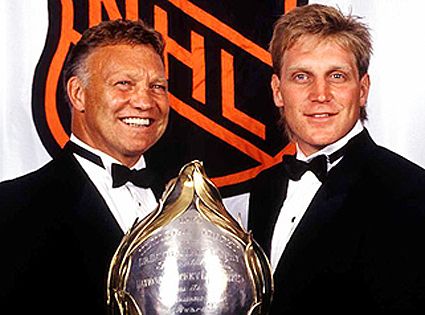
Two-time winner Bobby Hull celebrating Brett Hull's
1991 Hart Trophy as NHL MVP
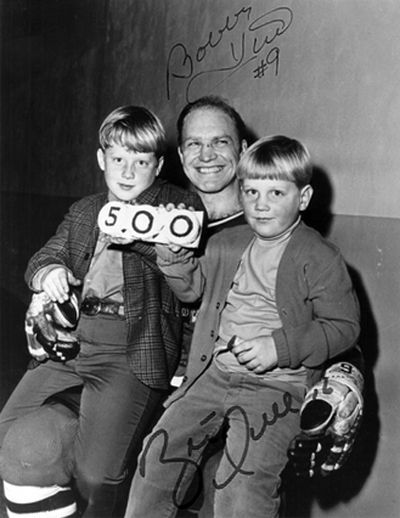
Bonus Jersey: Today's bonus jersey is a 1969-70 Chicago Black Hawks Bobby Hull jersey as worn when he scored his 500th NHL goal on February 21, 1970 in Chicago against the New York Rangers.
This jersey style was first introduced for the 1955-56 season and underwent several tweaks and evolutions, including varying locations of the secondary logo, the addition of black cuffs on the sleeves, sleeve numbers and a modernization of the crest until arriving at this style with the change from a lace-up collar to a v-neck in 1965-66. Since then, only the addition of red trim around the numbers and the arrival of names on the back are worth noting, as the jersey has remained essentially unchanged since 1965.

Two-time winner Bobby Hull celebrating Brett Hull's
1991 Hart Trophy as NHL MVP
Bobby Hull began his career with the Chicago Black Hawks in 1957 and would equal the NHL record of 50 goals in 1962 held by Maurice Richard (1945) and Bernie "Boom Boom" Geoffrion (1961). He would break the record in 1966 when he scored 54, the highest total in the Original Six era.
Bobby would top 50 goals three more times, in 1967 with 52 goals, 1969 with 58 (a personal best and the all-time record then) and 1972 with an even 50.
He would reach 500 goals on February 21, 1970 against the New York Rangers and finish his NHL career with 610 goals, currently 15th all-time. However, Hull did spend seven seasons with the Winnipeg Jets of the World Hockey Association, where he scored an additional 303 goals, giving him 913 for his entire career.

Bobby with sons Bobby Jr. and Brett after scoring his 500th NHL goal
Brett Hull would begin his path to 500 goals with the Calgary Flames when he scored his first NHL goal in the 1986-87 season while appearing in only 5 games. During the 1987-88 season Brett would score 26 goals in 52 games for Calgary before being traded to the St. Louis Blues, along with Steve Bozak for Rob Ramage and Rick Wamsley.
It was in St. Louis that Brett would ignite and achieve his first 40 goal season in 1988-89. A monster season in 1989-90 would see him join the elite 70 goal club with 72, joining the likes of Phil Esposito, Wayne Gretzky, Jari Kurri, Mario Lemieux and Bernie Nicholls.
Amazingly, Hull would beat that mark the very next season when he lit the lamp 86 times, the second highest single season mark ever, just six shy of Gretzky's 92.
Brett would continue his assault on the 500 mark with seasons of 70 in 1991-92, becoming only the second and final player to score 50 goals in 50 games more than once, 54 and then 57 over the next three seasons. The lockout shortened season of 1994-95 limited him to 29, but he reached 40 for the final two times of his career with 43 followed by 42 the season he reached 500, becoming just the 24th player at the time in the exclusive club and joining his father as the only father/son duo to achieve the feat together.
Hull would reach 500 in style, scoring a hat trick as part of a four point night against the Los Angeles Kings.
Hull would continue to play seven more seasons in the NHL, winning two Stanley Cups and adding another 241 goals to his tally to finish with 741, currently third all-time behind only Gretzky and Gordie Howe.
He joined his father in having his jersey number retired in 2006, the only father/son combo in any professional sport to be so honored, and then joined him in the Hockey Hall of Fame in 2009.
Combined, the Bobby and Brett scored 1,351 NHL goals with Bobby's brother Dennis Hull adding another 303 for a family total of 1,654.
Today's featured jersey is a 1996-97 St. Louis Blues Brett Hull jersey just like the one he wore when he scored goal number 500. This jersey style was worn from 1994-95 until the 1997-98 season before being replaced with the more traditional looking jersey first introduced as the Blues alternate jersey in 1997-98.
Many did not like the inclusion of what they felt was an excessive amount of red in the blues jersey, particularly the road version, along with what they felt was the excessive number of stripes, which were there to replicate the musical staff. The diagonal lines of the jersey were unconventional at the time, but even more so were the numbers, which grew in size from right to left across the back as the lines of the staff fell away.
Bonus Jersey: Today's bonus jersey is a 1969-70 Chicago Black Hawks Bobby Hull jersey as worn when he scored his 500th NHL goal on February 21, 1970 in Chicago against the New York Rangers.
This jersey style was first introduced for the 1955-56 season and underwent several tweaks and evolutions, including varying locations of the secondary logo, the addition of black cuffs on the sleeves, sleeve numbers and a modernization of the crest until arriving at this style with the change from a lace-up collar to a v-neck in 1965-66. Since then, only the addition of red trim around the numbers and the arrival of names on the back are worth noting, as the jersey has remained essentially unchanged since 1965.
In today's video section, Brett scores his 500th goal on this date in 1996.
Here's a look at Bobby in action from his days with Chicago. Note him coming up the steps from the locker room to reach the ice level in the quirky old Chicago Stadium.
Labels:
Hull Bobby,
Hull Brett,
St. Louis Blues
Subscribe to:
Comments (Atom)



